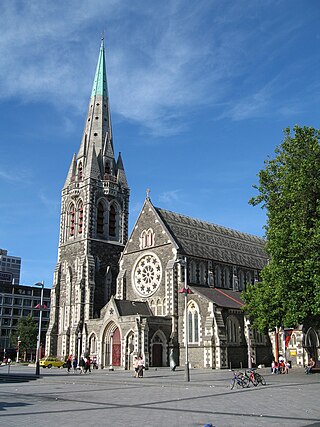
ChristChurch Cathedral, also called Christ Church Cathedral and (rarely) Cathedral Church of Christ, is a deconsecrated Anglican cathedral in the city of Christchurch, New Zealand. It was built between 1864 and 1904 in the centre of the city, surrounded by Cathedral Square. It became the cathedral seat of the Bishop of Christchurch, who is in the New Zealand tikanga of the Anglican Church in Aotearoa, New Zealand and Polynesia.
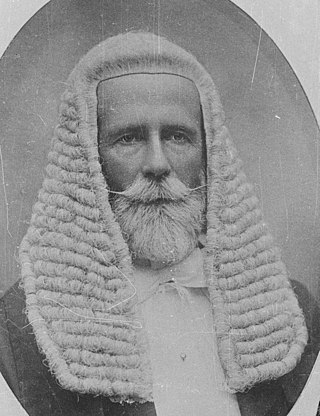
Sir Arthur Robert Guinness was a New Zealand politician, and Speaker of the House of Representatives.

Henry John Tancred, also known as Harry Tancred, was a 19th-century New Zealand politician.

The Outhwaite family were early settlers in Auckland, New Zealand and were a prominent family in Auckland in the first 85 years of the city's existence. They made substantial contributions to the legal, administrative, musical, literary, artistic, social and sporting life of the city. They were also important in the establishment and growth of the Catholic Church in Auckland and through their social and philanthropic activities. Their influence still continues, especially in respect of their donation of two areas of land in the central Auckland suburb of Grafton which are now Outhwaite Park and St Peter's College. The family also enabled the creation of a conservation reserve in the Hen and Chicken Islands.

William Varnham Millton was a New Zealand rugby union player and cricketer. He was the first captain of the New Zealand national rugby union team, leading them on their 1884 tour of New South Wales, and represented Canterbury in both rugby union and cricket.
John Joyce was a Member of Parliament for Lyttelton and Akaroa in the South Island of New Zealand.
Allan Holmes was an Australian-born New Zealand cricketer who played for Otago. He was a barrister at the Supreme Court.

James Arthur Flesher was a politician in Christchurch, New Zealand. He held many public offices and was Mayor of Christchurch from 1923 to 1925.

Francis James Garrick, was a barrister and politician from Christchurch, New Zealand.
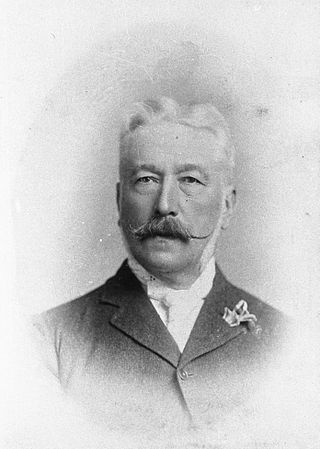
Edward Cephas John Stevens was a New Zealand politician in provincial government in Canterbury, and a member of both the lower and upper houses of parliament. A businessman, he controlled the Christchurch Press for many decades. He was instrumental in introducing cricket to Canterbury and one of his dealings as a land and estate agent resulted in the creation of Lancaster Park.
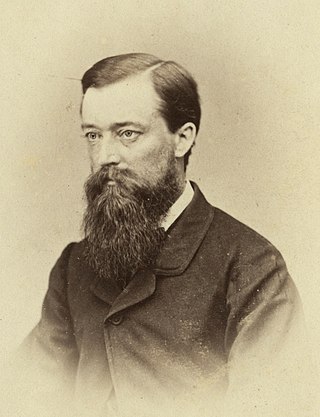
Crosbie Ward was a 19th-century member of parliament in New Zealand.
Alfred Richard Creyke JP was a 19th-century Member of Parliament in Canterbury, New Zealand. He was a significant landholder in Canterbury. Of English descent, he spent just over ten years in the colony before returning home.

Thomas Shailer Weston, often referred to as Thomas S. Weston, was a judge and 19th-century Member of Parliament from Westland, New Zealand. Weston was the patriarch of one of two dominant Canterbury families of the legal profession.

John Barton Arundel Acland, often referred to as J. B. A. Acland, was born in Devon, England, as the youngest child of Sir Thomas Dyke Acland, 10th Baronet. He followed his father's path of education and became a barrister in London. With his colleague and friend Charles George Tripp, he formed the plan to emigrate to Canterbury, New Zealand, to take up sheep farming. They were the first to take up land in the Canterbury high country for this purpose. When they divided their land into separate holdings, Acland kept the 100,000 acres (400 km2) that made up the Mount Peel station.

Arthur Morton Ollivier was a businessman in Christchurch, New Zealand, a cricketer, mountaineer, and chess player. Mount Ollivier is named after him.

Henry Barnes Gresson was a New Zealand judge.

Thomas Ingham Joynt was a senior member of the New Zealand legal profession from Christchurch. Born in Ireland, he emigrated to Canterbury with his wife and child in 1856. He had commenced legal training in Dublin and was admitted to the bar in 1863 in Christchurch; at the same time, he set up his own legal firm. Over the years, he formed various partnerships with other solicitors. Joynt became known as a defence lawyer and had many high-profile cases, but he was equally successful in civil cases. In 1907, when the first ten King's Counsel were appointed in New Zealand, Joynt was acknowledged as the senior member of the bar. He practised until shortly before his death.

Richard James Strachan Harman was trained as a civil engineer. However, in Christchurch, New Zealand, he worked as a bureaucrat, politician and businessman. He was one of the Canterbury Pilgrims, having arrived in Lyttelton, on Sir George Seymour, one of the First Four Ships. He was a business partner of Edward Cephas John Stevens and senior partner of Harman and Stevens, and together they took financial control of the Christchurch newspaper The Press from its original proprietor, James FitzGerald, over a protracted period. Harman held many important roles with the Canterbury Provincial Council and was the last Deputy-Superintendent.

The Christchurch mayoral election held on 27 November 1895 was contested by city councillors Howell Widdowson and Harry Beswick. Both candidates were young solicitors with few prior civic roles. Initially, the incumbent mayor—Walter Cooper—was one of the candidates but he withdrew. Widdowson attracted some controversy over the question whether he put his nomination forward ahead of a more senior city councillor; many voters still expected at the time that a mayoralty should be assigned to the most senior councillor. Another important issue for many voters was that Widdowson was a tee-totaller and was thus regarded as a prohibitionist, with Beswick seen as the representative of the liquor lobby. Beswick won the election with a clear majority and was installed as mayor of Christchurch on 18 December 1895.
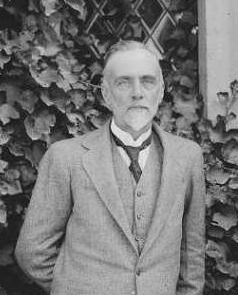
Henry Cotterill was a New Zealand cricketer who played three matches of first-class cricket for Canterbury between 1875 and 1885, and worked as a lawyer in Christchurch for more than 60 years. His law firm, Duncan Cotterill, is the largest in the South Island as of 2020.


















